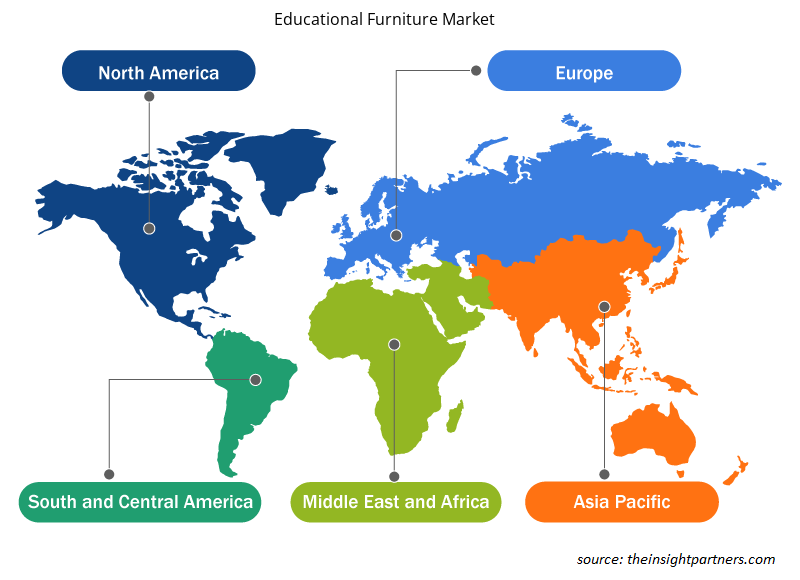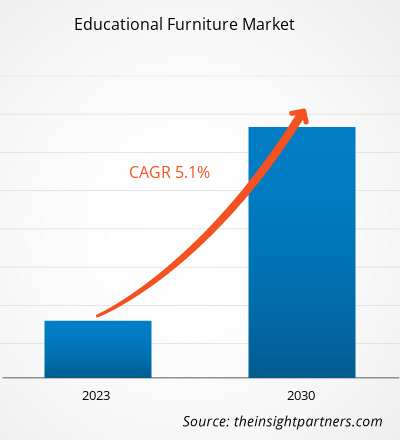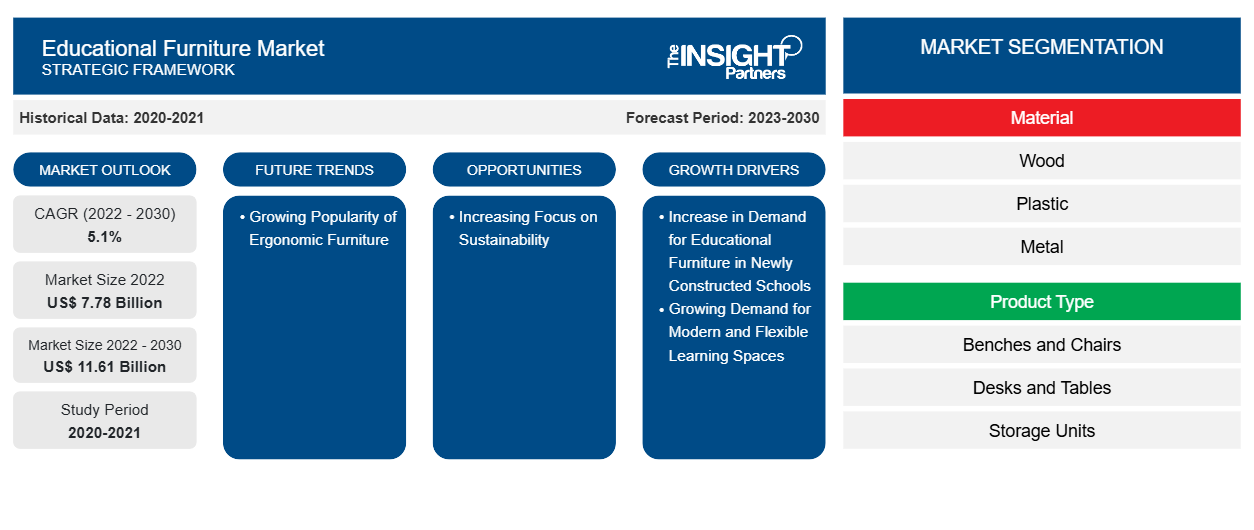[연구보고서] 교육용 가구 시장 규모는 2022년 7,783.45백만 달러에서 2030년 11,611.64백만 달러로 성장할 것으로 전망되며, 시장은 2022년에서 2030년까지 연평균 성장률 5.1%를 기록할 것으로 예상됩니다.CAGR of 5.1% from 2022 to 2030.
시장 통찰력 및 분석가 관점:
교육용 가구에는 책상, 의자, 화이트보드, 캐비닛, 수납장, 사물함 책상이 포함됩니다. 어린이의 올바른 자세를 보장하기 위한 인체공학적 가구 디자인에 대한 요구가 증가함에 따라 초등학교에서 현대적인 교육용 가구에 대한 수요가 증가하고 있습니다. 특히 팬데믹 이후 마이크로 스쿨링의 증가 추세는 유연한 교육용 가구에 대한 수요를 촉진합니다. 마이크로 스쿨은 학급 규모가 작기 때문에 개인화된 학습 환경을 제공합니다. 이러한 학교에서는 개별 작업, 그룹 프로젝트, 쉬운 학습을 촉진하는 대화형 소그룹 활동을 수용하기 위해 원형 테이블, 의자, 부드러운 좌석 의자, 조절 가능한 책상과 같은 유연한 가구가 필요합니다. 또한 미학에 대한 집중도가 높아져 학생들이 집중할 수 있는 편안한 학습 공간을 만드는 세련되면서도 내구성 있는 가구에 대한 수요가 증가합니다. 이러한 요소는 교육용 가구 시장의 성장을 크게 촉진합니다.
성장 동인 및 과제:
학교와 대학은 환경에 대한 민감성을 더욱 높이기 위해 노력하고 있으며, 따라서 지속 가능한 교육 가구에 대한 수요가 증가하고 있습니다. 교육자들이 학생들에게 환경 친화적 행동을 뒷받침하는 가치를 채택하도록 장려함에 따라 녹색 교실과 학교 전체의 "녹색화" 이니셔티브가 증가하고 있습니다. 지속 가능한 보관 제품, 의자 및 책상은 전 세계 교실에서 널리 선호됩니다. 이러한 가구 제품은 폴리프로필렌, 재생 가능한 목재 또는 강철과 같은 친환경 소재를 사용하여 제조되며, 이는 승인을 위해 의무적인 배출 표준을 충족합니다. 또한 실내 공기 질을 유지하도록 설계되었습니다.
가구 제조에 지속 가능한 소재를 사용하면 제조업체가 제품 폐기물을 재활용하여 폐기물이 매립지로 버려지는 것을 방지할 수도 있습니다. 예를 들어, Paragon Furniture Inc.는 목재 제품을 제조하는 데 재활용 또는 회수된 섬유를 사용합니다. 다양한 국가의 정부는 기업이 학교의 지속 가능한 건설을 촉진하는 제품을 도입하도록 장려하고 있습니다. 마찬가지로 미국 Green Building Council의 Leadership in Energy and Environmental Design(LEED) Green Building Rating System은 지속 가능하고 고성능 시설을 건설하고 학교 및 기타 교육 시설에 지속 가능한 가구를 도입하도록 장려합니다. 지속 가능한 인프라를 촉진하기 위한 이러한 이니셔티브의 수가 증가함에 따라 향후 몇 년 동안 교육용 가구 시장 성장에 수익성 있는 기회가 생길 가능성이 높습니다.
귀하의 요구 사항에 맞게 이 보고서를 사용자 정의하세요
이 보고서의 일부 또는 국가 수준 분석, Excel 데이터 팩을 포함하여 모든 보고서에 대한 사용자 정의를 무료로 받을 수 있으며 신생 기업 및 대학을 위한 훌륭한 혜택과 할인 혜택을 이용할 수 있습니다.
-
이 보고서의 주요 시장 동향을 알아보세요.이 무료 샘플에는 시장 동향부터 추정 및 예측까지 다양한 데이터 분석이 포함됩니다.
보고서 세분화 및 범위:
"글로벌 교육용 가구 시장"은 재료, 제품 유형, 최종 용도 및 지리를 기준으로 세분화됩니다. 재료에 따라 교육용 가구 시장은 목재, 플라스틱, 금속 및 기타로 세분화됩니다. 제품 유형별로 시장은 벤치와 의자, 책상과 테이블, 보관 장치 및 기타로 세분화됩니다. 최종 용도 측면에서 시장은 기관 및 주거로 분류됩니다. 기관 세그먼트는 초등학교, 중등학교 및 고등 교육으로 세분화됩니다. 지리적으로 교육용 가구 시장은 북미(미국, 캐나다 및 멕시코), 유럽(독일, 프랑스, 이탈리아, 영국, 러시아 및 기타 유럽), 아시아 태평양(호주, 중국, 일본, 인도, 한국 및 기타 아시아 태평양), 중동 및 아프리카(남아프리카, 사우디 아라비아, UAE 및 기타 중동 및 아프리카), 남중미(브라질, 아르헨티나 및 기타 남중미)로 세분화됩니다.
세그먼트 분석
교육용 가구 시장은 소재에 따라 목재, 플라스틱, 금속 등으로 세분화됩니다. 2021년에는 목재 부문이 가장 큰 시장 점유율을 차지했습니다. 목재 가구는 다른 소재에 비해 내구성이 뛰어나고 유지 관리가 간편하기 때문에 전 세계적으로 가장 인기 있는 가구 중 하나입니다. 또한 목재 가구는 플라스틱이나 기타 인공 소재에 비해 가장 친환경적이고 지속 가능한 솔루션 중 하나입니다. 소비자 사이에서 수요가 높기 때문에 목재는 전통적으로 가구 생산에 가장 선호되는 소재입니다.
최종 사용 기준으로 기관 부문이 2022년에 가장 큰 점유율을 차지했습니다. 교육 부문의 디지털 혁신으로 디지털 학습 요구 사항을 충족하는 가구에 대한 수요가 증가했습니다. 대학은 노트북, 태블릿, 디지털 교과서를 수용할 수 있는 가구에 점점 더 많이 투자하고 있습니다. 이러한 기관은 학생과 교수진을 유치하고 학습 환경을 개선하기 위해 도서관, 카페테리아, 실험실, 회의실과 같은 눈에 잘 띄는 구역에 미적 가구에 투자하고 있습니다. 전 세계 선진국과 개발도상국에서 초등 교육과 고등 교육의 중요성이 커지면서 대학, 대학교, 학교에 등록한 학생 수가 시간이 지남에 따라 증가하고 있습니다. 국가 교육 통계 센터에 따르면 2021년에 미국에서 약 1,900만 명의 학생이 대학에 다녔습니다. 학생 등록 수가 증가함에 따라 현대적이고 인체공학적으로 설계된 교육용 가구에 대한 수요가 증가하고 있습니다. 이러한 요인이 교육용 가구 시장 성장을 크게 촉진하고 있습니다.
지역 분석:
지리적으로 교육용 가구 시장은 북미, 유럽, 아시아 태평양, 남미 및 중미, 중동 및 아프리카의 5개 주요 지역으로 나뉩니다. 글로벌 교육용 가구 시장은 북미가 주도했으며, 2022년에 3,493.99백만 달러를 차지했습니다. 유럽은 두 번째로 큰 기여자로, 글로벌 시장의 약 24%를 차지합니다. 또한 아시아 태평양은 예측 기간 동안 5~6%의 CAGR로 상당히 성장할 것으로 예상됩니다. 미국은 이 지역 시장에 크게 기여하고 있으며, 그 뒤를 캐나다와 멕시코가 따릅니다. 북미의 교육 기관은 기존 리소스를 업그레이드하고 혁신적인 가구를 조달하고 있습니다. 효과적인 제조 및 무역 정책도 교육용 가구 시장의 성장에 기여하고 있습니다. 또한, 특히 잘못된 자세로 인해 발생하는 어린이의 건강 문제를 예방하기 위한 인체공학적으로 설계된 학교 가구가 이 지역에서 상당한 인기를 얻고 있습니다. 미국은 Fleetwood Furniture, Herman Miller Inc, Steelcase Inc 등 주요 교육용 가구 제조업체의 입지를 나타냅니다. 또한 Simplova, Institutional Furniture Ltd, RJH Solutions, CDI Spaces는 캐나다에서 운영되는 교육용 가구 제조업체 및 공급업체 중 일부입니다. American Society of Civil Engineers에서 발행한 2021 Infrastructure Report Card에 따르면 미국에는 약 100,000개의 건물이 있는 약 84,000개의 공립학교가 있으며, 2026년까지 등록 학생 수는 5,680만 명으로 추산됩니다. 따라서 학교 수의 증가, 현대적이고 인체공학적인 가구에 대한 성향, 교육용 가구 제조업체의 입지가 예측 기간 동안 북미의 교육용 가구 시장을 활성화할 것으로 예상됩니다.
산업 발전 및 미래 기회:
교육용 가구 시장의 주요 업체가 취한 다양한 이니셔티브는 아래와 같습니다.
- 2022년에 AFC Furniture Solutions는 Xbench, Vibrant, Livo 등의 브랜드를 디자인하고 소유한 Wipro Enterprises를 인수했습니다.
- 2023년에 Smith System과 모회사인 Steelcase는 6개의 새로운 프리미어 딜러 파트너 지정을 발표했습니다.
교육용 가구 시장 지역 통찰력
Insight Partners의 분석가들은 예측 기간 동안 교육용 가구 시장에 영향을 미치는 지역적 추세와 요인을 철저히 설명했습니다. 이 섹션에서는 북미, 유럽, 아시아 태평양, 중동 및 아프리카, 남미 및 중미의 교육용 가구 시장 세그먼트와 지리에 대해서도 설명합니다.

- 교육용 가구 시장에 대한 지역별 특정 데이터 얻기
교육용 가구 시장 보고서 범위
| 보고서 속성 | 세부 |
|---|---|
| 2022년 시장 규모 | 77억 8천만 달러 |
| 2030년까지 시장 규모 | 116억 1천만 달러 |
| 글로벌 CAGR (2022-2030) | 5.1% |
| 역사적 데이터 | 2020-2021 |
| 예측 기간 | 2023-2030 |
| 다루는 세그먼트 |
재료별로
|
| 포함된 지역 및 국가 |
북아메리카
|
| 시장 선도 기업 및 주요 회사 프로필 |
|
교육용 가구 시장 참여자 밀도: 비즈니스 역학에 미치는 영향 이해
교육용 가구 시장은 소비자 선호도의 변화, 기술 발전, 제품의 이점에 대한 인식 증가와 같은 요인으로 인해 최종 사용자 수요가 증가함에 따라 빠르게 성장하고 있습니다. 수요가 증가함에 따라 기업은 제품을 확장하고, 소비자의 요구를 충족하기 위해 혁신하고, 새로운 트렌드를 활용하여 시장 성장을 더욱 촉진하고 있습니다.
시장 참여자 밀도는 특정 시장이나 산업 내에서 운영되는 회사나 기업의 분포를 말합니다. 주어진 시장 공간에 얼마나 많은 경쟁자(시장 참여자)가 존재하는지 그 규모나 전체 시장 가치에 비해 나타냅니다.
교육용 가구 시장에서 활동하는 주요 회사는 다음과 같습니다.
- AFC Furniture Solutions Pvt Ltd
- 플리트우드 그룹 주식회사 Group Inc
- 스콜라크래프트 프로덕츠 주식회사
- 스미스 시스템 제조 회사
- 놀 주식회사
면책 조항 : 위에 나열된 회사는 어떤 특별한 순서에 따라 순위가 매겨지지 않았습니다.

- 교육용 가구 시장 주요 업체 개요를 알아보세요
COVID-19 영향:
COVID-19 팬데믹의 초기 단계에서 봉쇄 제한과 제조 단위의 폐쇄로 인해 생산 부족이 발생하여 수요와 공급 격차가 발생했습니다. 다양한 소규모 및 대규모 교육용 가구 제조업체의 수익성은 크게 저해되었습니다. 그러나 교육 기관과 학교는 온라인 수업을 통해 원격으로 작업하고 있어 집에서 책상과 의자와 같은 가구에 대한 수요가 급증했습니다. 학교와 대학의 원격 작업과 온라인 코칭의 증가로 인해 집에서 편안한 좌석에 대한 필요성이 증가함에 따라 교육용 가구 제품에 대한 수요가 증가했습니다.
2021년에 다양한 경제권이 운영을 재개했고, 다양한 국가의 정부가 이전에 부과된 제한을 완화한다고 발표하면서 글로벌 시장이 활성화되었습니다. 제조업체는 최대 용량으로 운영할 수 있었고, 이는 수요와 공급 격차 및 기타 반향을 극복하는 데 도움이 되었습니다. 많은 국가의 수많은 시민이 2021년까지 완전히 백신을 접종함에 따라 교육용 가구 제조업체는 사업을 되살리기 위해 생산을 늘리는 데 집중했습니다. 이는 교육용 가구 시장의 성장에 긍정적인 영향을 미쳤습니다.
경쟁 환경 및 주요 회사:
글로벌 교육용 가구 시장에서 운영되는 상위 10개 회사는 AFC Furniture Solutions Pvt Ltd, Fleetwood Group Inc, Scholar Craft Products Inc, Smith Systems Manufacturing Co, Knoll Inc, Haworth Inc, Vitra International AG, Virco Manufacturing Corp, Office Line Srl, Creaciones Falcon SLU입니다. 이러한 업체는 소비자 수요에 부응하기 위해 인체공학적 디자인의 혁신적인 가구를 개발하는 데 중점을 둡니다.
- 과거 분석(2년), 기준 연도, CAGR을 포함한 예측(7년)
- PEST 및 SWOT 분석
- 시장 규모 가치/거래량 - 글로벌, 지역, 국가
- 산업 및 경쟁 환경
- Excel 데이터세트
최근 보고서
사용 후기
구매 이유
- 정보에 기반한 의사 결정
- 시장 역학 이해
- 경쟁 분석
- 고객 인사이트
- 시장 예측
- 위험 완화
- 전략 기획
- 투자 타당성 분석
- 신흥 시장 파악
- 마케팅 전략 강화
- 운영 효율성 향상
- 규제 동향에 발맞춰 대응























 무료 샘플 받기 - 교육용 가구 시장
무료 샘플 받기 - 교육용 가구 시장